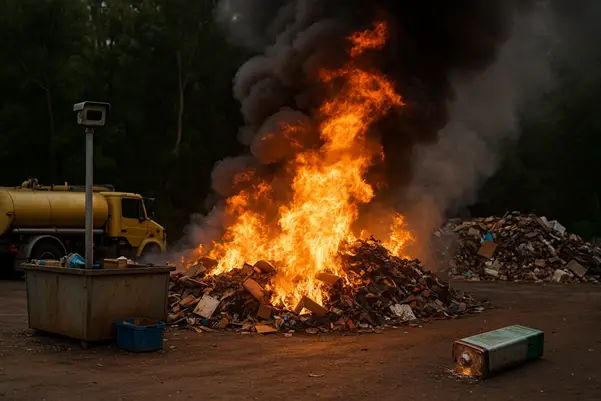Lithium-ion batteries (LiBs) are an escalating fire hazard within Australia’s waste management and resource recovery industry. According to the Australian Council of Recycling (ACOR), an estimated 10,000 to 12,000 battery-related fires occur annually across the country. Many of these incidents involve lithium-ion batteries discarded in garbage trucks, recycling centres, and landfills. These fires pose serious risks to workers and the public and also drive up the operational costs and insurance premiums of waste services, disruptions and safety concerns.
Why lithium-ion batteries are dangerous
LiBs are particularly volatile when damaged or improperly handled. At recycling centres, they are often crushed, punctured, or overheated, triggering a chain reaction known as thermal runaway. This phenomenon involves a rapid spike in temperature that causes one cell to ignite, rapidly spreading fire to adjacent cells. The result is an intense, long-lasting blaze that’s extremely difficult to extinguish and may release toxic gases harmful to both human health and the environment.
Adding to the risk, lithium batteries are often embedded in consumer products like e-cigarettes, vapes, or small electronics. When these devices are mistakenly discarded in general waste, the batteries may be damaged during sorting and compacting – becoming a hidden ignition source. Given the abundance of flammable materials in waste facilities, even a single lithium battery fire can lead to catastrophic outcomes.
Where and When These Fires Occur
Contrary to common belief, many lithium battery fires don’t occur during use, but after disposal, especially during waste collection, sorting and recycling processes. The challenge lies in the invisibility of the threat – batteries are small, concealed within products, and especially overlooked. When they are compressed or broken apart in machinery, the risk of ignition dramatically increases.
Preventing and Responding to Lithium Battery Fires
For the Public:
- Never dispose of lithium batteries or battery-powered devices in general waste.
- Use designated battery collection bins or e-waste drop-off points for safe disposal.
- Inspect batteries for signs of damage, swelling, or overheating before disposal.
For Waste and Resource Recovery Centre (WRCs):
- Improve early-stage screening to detect hidden batteries before processing.
- In case of fire, immediately isolate burning materials and move them to a safe and open space. Remove the unaffected waste to prevent fire spread.
- If a lithium battery is identified, it should be promptly isolated and cooled to reduce the risk of thermal runaway.
- Train staff on lithium battery risks and specific emergency response procedures.
A cell for comprehensive Action
Fire caused by lithium batteries is now a persistent and dangerous threat in Australia’s waste management sector. Their frequency, hidden nature, and destructive power demand a coordinated national response. Solutions must span from public awareness campaigns to industry protocols and police support, ensuring effective prevention, safe handling, and quick emergency response. Only with a unified strategy can we mitigate the growing risk posed by these powerful yet hazardous energy sources.
ACOR. (2024). Battery fire survey summary. Australian Council of Recycling. Available at: https://acor.org.au/wp-content/uploads/2024/06/240603-ACOR-battery-fire-survey-summary.pdf (Accessed: 6 February 2025).
United States Environmental Protection Agency (2021). An Analysis of LiB Fires in Waste Management and Recycling. EPA 530-R-21-002.
Baker, E. (2024, 6). Lithium-ion batteries are causing more than 10,000 fires a year in Australia. Waste chiefs say an ‘urgent’ management plan is needed. Retrieved from https://www.abc.net.au/news/2024-06-20/lithium-ion-batteries-10000-fires-australia-waste-management/104002912?utm_source=chatgpt.com

